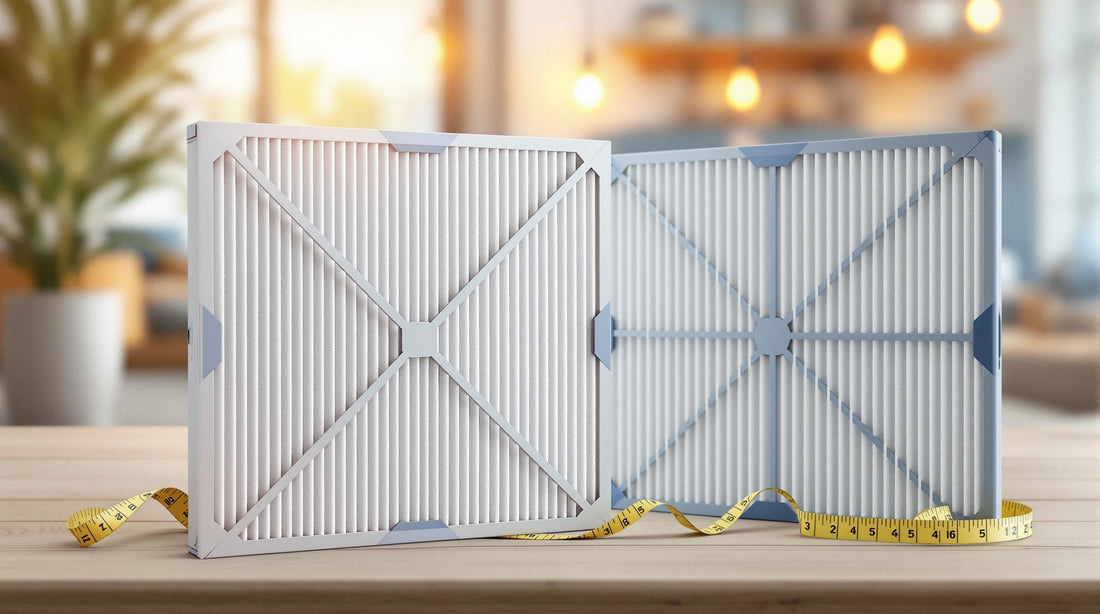
Furnace Filter Buying Guide: What Size Do You Need?
Share
Choosing the right furnace filter size is simple and crucial for clean air and efficient HVAC performance.
Here’s a quick guide to get started:
- Check the label: Most filters display a nominal size (e.g., 20"x20"x1") and a smaller actual size (e.g., 19.5"x19.5"x0.75").
- Measure your filter slot: Use a tape measure to find the length, width, and depth. Subtract 0.25"-0.5" for a snug fit.
- Know standard sizes: Common sizes include 16"x25"x1", 20"x20"x1", and 14"x20"x1".
- Pick the right thickness: Thin filters (1") are cheaper but need frequent replacement. Thicker filters (4") last longer and improve airflow but may not fit all systems.
Quick Tip: Always align the filter with the airflow direction arrow printed on its frame.
Using the correct size ensures better air quality, lower energy bills, and longer HVAC life.
For more details on measuring, comparing thickness, and washable options, keep reading.
How to Get HVAC Air Filter Size Measurement Easy Simple
Filter Size Basics
Furnace filters come with two measurements - nominal and actual - that you need to understand to ensure the filter fits correctly and your HVAC system works efficiently.
Nominal vs. Actual Sizes
Filters display two size measurements: nominal (a rounded, standard number printed prominently) and actual (a slightly smaller size for proper installation).
"Nominal means 'in name only,' and is used in many industries – including HVAC and lumber – as a way of naming standardized dimensions. So, the nominal size is the one you'll look for when shopping for an AC or furnace filter." - Factory Direct Filters
For instance, a filter labeled as 20" x 20" x 1" nominal size will typically have an actual size of 19½" x 19½" x ¾". This difference, called the "undercut", ensures the filter fits snugly while being easy to install.
Standard Filter Sizes
Here are some commonly used furnace filter sizes in U.S. homes:
| Nominal Size (inches) | Actual Size (inches) |
|---|---|
| 16" x 25" x 1" | 15.5" x 24.5" x 0.75" |
| 20" x 20" x 1" | 19.5" x 19.5" x 0.75" |
| 16" x 20" x 1" | 15.5" x 19.5" x 0.75" |
| 14" x 20" x 1" | 13.5" x 19.5" x 0.75" |
| 14" x 25" x 1" | 13.5" x 24.5" x 0.75" |
Always double-check the label on your filter to confirm its dimensions.
Reading Size Labels
Look for the size information printed on the filter's frame. Manufacturers typically display both nominal and actual sizes, with the nominal size being more prominent. If the label is missing, measure the filter slot directly. The filter should be ¼" to ½" smaller than the slot opening.
Filter dimensions are listed in the order of length x width x depth.
Measuring Your Filter
Locating Your Filter
Before you measure, you'll need to find your furnace filter. Its location depends on the type of HVAC system you have:
-
Vertical units:
- For upward airflow, check the bottom door near the blower.
- For downward airflow, look at the top door by the blower. Some systems may use two filters.
- Horizontal units: The filter is usually in a rack on the intake side.
Other possible locations include:
- Behind the metal compartment door near the floor or side of the furnace
- Inside return air grills (mounted on walls or ceilings)
- Within the furnace blower compartment
- Inside the air handler
How to Measure
Once you’ve located the filter, measure its length, width, and depth:
- Length: Measure the longest side from edge to edge.
- Width: Measure the second-longest side.
- Depth: Measure the thickness, which usually ranges between 1 and 5 inches.
| Filter Dimension | Common Nominal Sizes | Typical Actual Sizes |
|---|---|---|
| Depth (thickness) | 1 inch | 3/4 – 7/8 inch |
| Depth (thickness) | 2 inches | 1.75 inches |
| Depth (thickness) | 4 inches | 3.75 inches |
Tips for Accurate Measurements
- Measure the interior dimensions of the filter slot, but subtract about 3/8 inch to account for obstructions like stop tabs, screws, or rivets.
- If your home has multiple filter slots, measure each one individually.
When measuring an empty slot, take into account any physical barriers and leave enough clearance to ensure the filter fits snugly while allowing proper airflow. This will help your HVAC system run efficiently.
sbb-itb-adeab55
Filter Thickness Options
Thin vs. Thick Filters
The thickness of your furnace filter plays a big role in how well it performs and how often it needs replacing. A 1-inch filter typically costs between $5 and $15, lasts for 1–2 months, and may restrict airflow when paired with higher MERV ratings. On the other hand, a 4-inch filter, which contains 20–30 feet of pleated media, costs between $20 and $30 and lasts 6–12 months.
System Compatibility Check
It's important to confirm that your system can support a thicker filter. Here's how to check:
"Air filter thickness depends largely on your furnace configuration. Choose the thickest air filter you can for maximum efficiency, but never try to force an air filter to fit into a space it isn't designed for."
Steps to determine compatibility:
- Measure the filter housing depth: Ensure your current filter slot can fit a thicker filter.
- Check system specifications: Look at your furnace manual or reach out to the manufacturer.
- Assess airflow needs: Consider your system's static pressure limits to avoid performance issues.
A 4-inch filter can improve air quality and reduce strain on your HVAC system by allowing better airflow. However, forcing a thicker filter into a space meant for a 1-inch filter could harm components and lower efficiency.
For the best results, consult with an HVAC professional. They can assess your system and recommend any necessary adjustments for using a thicker filter.
Washable Filter Selection
Why Choose Washable Filters
Washable filters can save you money and reduce waste. A high-quality washable filter may last up to ten years, replacing anywhere from 20 to 60 disposable filters during its lifespan. Most users see savings within the first ten months, as there’s no need for frequent replacements.
Key Features to Look For
The right washable filter should meet specific technical standards to deliver the best performance. Here are some important features to consider:
| Feature | Specification | Benefit |
|---|---|---|
| MERV Rating | MERV 7 | Provides effective filtration without restricting airflow |
| Filter Media | Woven polymer screens | Traps more particles effectively |
| Treatment | Antimicrobial agents | Reduces bacteria growth |
| Construction | Multi-layer design | Boosts filtration capability |
| Durability | +10-year lifespan | Reliable performance over time |
These filters use an electrostatic design to capture common pollutants like dust mites, pollen, and pet dander. Once you’ve confirmed these specifications, ensure the filter fits your system perfectly by opting for custom sizing if needed.
Custom Size Options
Getting the correct filter size is essential for proper performance. Follow these steps to ensure accuracy when selecting a custom size:
- Measure precisely: Record the length, width, and thickness of your current filter slot with care.
- Be aware of size limits: Filters larger than 29 inches in any dimension may require special handling and additional costs.
- Account for frame thickness: Make sure there’s enough clearance in your filter housing.
For oversized filters, note there’s a $50 material/labor surcharge and a $25 shipping fee.
"At ElectroDust, we prioritize transparency and reliability, ensuring that our filters not only meet but exceed expectations in actual usage conditions. By choosing ElectroDust filters, customers can trust that they are making a conscientious choice for the environment without compromising on quality or efficiency."
Customer feedback highlights the importance of proper sizing. Gilbert M. shared: "This exactly what I was looking for to replace the one I was using for the past 10 yrs. I'm quite happy that I could buy them directly from the manufacturer. They were delivered on time. Thanks for a very good product."
Filter Installation Guide
Airflow Direction
Getting the airflow direction right is key to your filter's performance. Look for the arrow on the filter and make sure it's pointing toward the furnace or ductwork. For upflow furnaces, the arrow should face upward toward the blower. In downflow systems, it should point downward. For horizontal systems, align the arrow with the airflow direction. If you're using a HEPA filter without an arrow, install it with the side that has a metal or wire mesh facing the incoming air.
"It's critical that you install it so the arrow indicating airflow on the filter is directed toward your furnace or ductwork." - Moncriefair.com
Secure Installation
Once the filter is aligned correctly, ensure it fits tightly in its compartment. A snug fit is crucial to prevent air from bypassing the filter, which could reduce efficiency. The filter should slide in smoothly without bending or forcing, leaving no gaps for air to escape.
Summary
Accurate filter sizing is crucial for maintaining system efficiency and ensuring clean air. Typically, the actual dimensions of a filter are about 0.25″–0.5″ smaller than the nominal (advertised) size, which allows for a secure fit. Here are three ways to determine the right size:
- Check the existing filter label: Look at the label on your current filter and note the dimensions in L x W x H format.
- Measure your current filter: Use a tape measure to determine the length, width, and depth. Round up these measurements to find the nominal size.
- Measure the air intake slot: Measure the dimensions of the slot where the filter fits. Round down to the nearest whole number, ensuring the filter leaves about 1–2 fingers' width from the corners.
Using these methods helps you find the perfect fit quickly and efficiently. ElectroDust filters, known for their high quality and customer satisfaction, are an excellent choice. The brand holds a 4.6/5 rating from 84 reviews, with one customer sharing:
"High-quality material. The air in my house is cleaner/fresher now. Super easy to install. Canadian made product too! Would definitely buy again!"
A properly sized filter slides in easily, seals tightly, and prevents unfiltered air from passing through. This not only improves air quality but also helps extend the life of your system.
